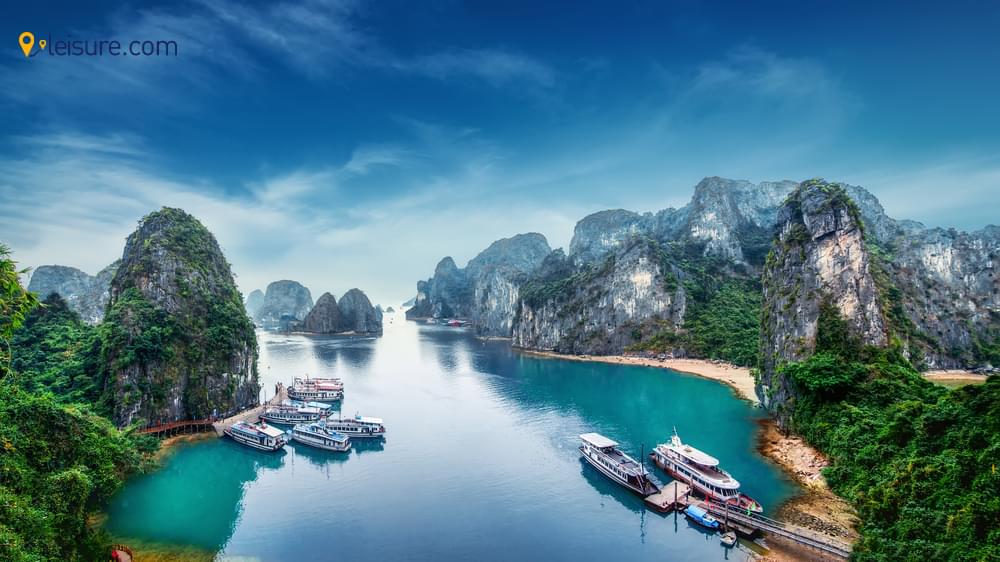Vietnam Tours
Planning Luxury Vietnam Trips with Leisure!
Vietnam is a mesmerizing destination that has a rich history, immersive culture, and picturesque natural hotspots. From the busy streets of Ho-Chi-Minh City to the peaceful rice fields of Sapa, the country offers a variety of experiences for each tourist who comes. Make sure to explore old towns that are filled with artisan shops and the indulgent historic citadels and pagodas. The thrill seekers must trek through the Mekong Delta, rent out a kayak in the emerald bays, and explore the secret nooks of the country.
You must travel along the idyllic islands of the country and indulge in the local cuisine, from steaming bowls of Pho to the world-famous Vietnamese coffee.
The country offers something for everyone with its diverse cultural heritage, lush flora and fauna, and modern urban lifestyle that presents itself as the perfect mix of tradition and progress. The locals of Vietnam also take care of their tourists with warm hospitality, giving you a rich experience. To plan the perfect luxury Vietnam tour, get ready to enjoy urban escape and thrilling adventures in this must-visit place on your list.
Plan the Perfect Vietnam Tour For You!
To plan the best Vietnam luxury tour, you must explore the captivating sights it has to offer. You must include traveling to North Vietnam to immerse yourself in the culture of Hanoi and its historical hotspots to learn about the country’s legacy. Central Vietnam leads you through pretty strolls along the local streets donned with attractive lanterns, finger-licking delicacies, and handmade crafts that are a sight for sore eyes.
Vietnam offers the perfect peaceful escape in the form of authentic rural life and traditions. The country invites tourists from all over the world to indulge themselves in this culture filled with regional dishes with fresh seafood. So, look forward to an assortment of adventure, enlightenment, relaxation, and experiences that will stay in your heart forever.
To book the best Vietnam tour package, you should explore the variety the country has to offer. The best time to visit Vietnam is usually between November and April, which will let you enjoy comfy, warm winds and beautiful outdoor experiences. The next would be to select your preferred hotspots based on your interests.
For history enthusiasts, Hanoi gives you ancient temples and war museums to help you understand the city’s formation. Ha Long Bay carries the title of a UNESCO World Heritage site famous for its limestone karsts. If you’re a beach person, you must head to Phu Quoc Island to enjoy the warm sands and luxury resorts with exclusive plans to make your day happier. To fully experience the cultural backdrop, you have multiple accommodation options, each based on your idea of the perfect comfort zone. You can choose to stay at the Reverie Saigon for its luxe hospitality or live in the gorgeous beachfront villas at the Vinpearl Resort. For a truly exclusive experience, plan a private tour through the Mekong Delta to shop from the floating markets, local villages, and restaurants. Get on a helicopter to enjoy a bird’s eye view of the city’s unique skyline.
When visiting Vietnam, you must be aware of local customs, such as dressing modestly, removing shoes at temples and houses, and greeting local elders with respect. The country frowns upon public displays of affection and expects tourists to soak in the culture as it is.
Choose the Best Vietnam Itinerary For You!
Vietnam provides the ideal backdrop to create a lifetime full of memories. Here are some customized Vietnam travel itineraries for the unique traveler in you to help you make the most of your trip.
This is the perfect 9-day trip for you to relax, seek an adrenaline rush, and soak in the culture of a new place in the world. Visit the Temple of Literature to learn more about the country’s rich cultural background. Book an exclusive cruise while enjoying the stunning views of the city’s skies for a laid-back vibe.
Vietnam offers many 7-day options for families to learn, have fun, and seek thrilling adventures. Visit Ha Long Bay and book a family-friendly cruise to swim and kayak in the peaceful waters of the destination. Include Hoi An and cycle through the serene paddy fields, attend artisanal workshops, and make sand castles on An Bang Beach.
In 8 days, experience true luxury in the cradles of nature by booking a tour of Vietnam. Take peaceful strolls along the sides of Hoan Kiem Lake. Plan a beautiful escape from the daily at Hoi An and dine by the river to enjoy the perfect romantic getaway.
Leisure gives you a new take on planning exclusive travel experiences by managing all the formalities of your trip from start to finish. By offering personalized services, we allow you to tailor your trips to your likes and interests. We take responsibility for giving you the perfect vacation of your life. We ease your travel bookings by actively booking exclusive deals with luxury cruise bookings so you can spend on what you deserve.
We also offer efficient services such as flight booking and private jet booking with a highly attentive and customizable process. Our teams take the load while you relax on the sandy beaches or cold mountains. We ensure that each moment of your trip is meaningful and customized according to your person.
Choose Leisure to plan a truly stress-free vacation with our high-end hospitality and unmatchable experiences.
Luxury Tours
Explore the Best Luxury Travel to Vietnam Tours
These related tours can be tailored to perfectly suit your unique travel style.

Here's Your Luxury 12-Days Vietnam Travel Guide
The easternmost country located on the Indochina Peninsula, Vietnam is an amazing Southeast Asian country. Boasting a number of sightseeing destinations, nightlife, things to do, and other travel highlights, the country attracts tourists from far and wide. So, check out our Vietnam travel guide and get facilitated with value for money by vacationing this gorgeous land.

Vietnam Budget Tour: Experience The Culture and History of Vietnam
Vietnam is a heavenly getaway for most travelers who love food. The country is embellished with a great coherence of history and medieval culture merged with spirituality, humble living, and a captivating lifestyle. A destination which can be traveled to, at any given time, it reflects the vibrant and lively culture of this land! Join our Vietnam budget tour and see this fascinating country like never before.

Vietnam Trip 2025: Your 2 Weeks Classic Vietnam Tour Itinerary
A Southeast Asian country on the South China Sea, Vietnam is known for its gorgeous beaches, rivers, and Buddhist pagodas. With its 3,000 kilometers of tropical coastline, the beautiful country offers mouth-watering food and fascinating culture, which hooks the tourists coming here. There is a lot to explore and discover in this amazing country which you can accomplish by joining our Vietnam trip 2025.

Cheap Vietnam tours - A 3 Days Northern Vietnam Trip
If you are planning a short trip into the beauty of nature then this 3-Days Cheap Vietnam Tours Itinerary is the perfect thing. We know how tedious it is to plan a short trip when you have so much in your mind but have just a few days to discover something new. And, to help you resolve that confusion, we have designed this 3-Days Vietnam tours. This will take you to the most beautiful corners of the country!
-1671002335-r.jpg)
The Ultimate 8 Day Luxury Vacation To Vietnam
This 8-day journey explores Vietnam's history, culture, and cuisine. Enjoy sightseeing in Halong Bay; visit the Ho Chi Minh Mausoleum and Halong Bay.

Your Perfect Vietnam Trip 2019 - 10 Days Itinerary
Are you planning your perfect Vietnam Trip 2019? Catch up with our planned 10-Days Itinerary and it will show you the numerous ways to Travel Smarter In Vietnam. Talk of a Holiday destination in South East Asia and Vietnam will appear at the top of the list. This spectacular trip has been designed for those who want to tick off Vietnam from their Bucket list of travel destinations in 2019.



